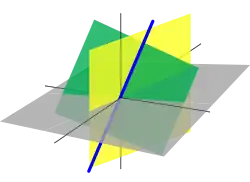In mathematics, the following inequality is known as Titu's lemma, Bergström's inequality, Engel's form or Sedrakyan's inequality, respectively, referring to the article About the applications of one useful inequality of Nairi Sedrakyan published in 1997,[1] to the book Problem-solving strategies of Arthur Engel published in 1998 and to the book Mathematical Olympiad Treasures of Titu Andreescu published in 2003.[2][3] It is a direct consequence of Cauchy–Bunyakovsky–Schwarz inequality. Nevertheless, in his article (1997) Sedrakyan has noticed that written in this form this inequality can be used as a proof technique and it has very useful new applications. In the book Algebraic Inequalities (Sedrakyan) several generalizations of this inequality are provided.[4]
Statement of the inequality
For any real numbers  and positive reals
and positive reals  we have
we have  (Nairi Sedrakyan (1997), Arthur Engel (1998), Titu Andreescu (2003))
(Nairi Sedrakyan (1997), Arthur Engel (1998), Titu Andreescu (2003))
Probabilistic statement
Similarly to the Cauchy–Schwarz inequality, one can generalize Sedrakyan's inequality to random variables. In this formulation let  be a real random variable, and let
be a real random variable, and let  be a positive random variable. X and Y need not be independent, but we assume
be a positive random variable. X and Y need not be independent, but we assume ![{\displaystyle E[|X|]}](./_assets_/b0b938ab6ff8930def5745adf294af60640bccc8.svg) and
and ![{\displaystyle E[Y]}](./_assets_/24c547cd81d1342e3277114c49a0ed989e461aab.svg) are both defined. Then
are both defined. Then ![{\displaystyle \operatorname {E} [X^{2}/Y]\geq \operatorname {E} [|X|]^{2}/\operatorname {E} [Y]\geq \operatorname {E} [X]^{2}/\operatorname {E} [Y].}](./_assets_/b74ebad496f0468a9233c171d6f6fb24818c41f7.svg)
Direct applications
Example 1. Nesbitt's inequality.
For positive real numbers 

Example 2. International Mathematical Olympiad (IMO) 1995.
For positive real numbers  , where
, where  we have that
we have that 
Example 3.
For positive real numbers  we have that
we have that 
Example 4.
For positive real numbers  we have that
we have that 
Proofs
Example 1.
Proof: Use 
 and
and  to conclude:
to conclude: 
Example 2.
We have that ![{\displaystyle {\frac {{\Big (}{\frac {1}{a}}{\Big )}^{2}}{a(b+c)}}+{\frac {{\Big (}{\frac {1}{b}}{\Big )}^{2}}{b(a+c)}}+{\frac {{\Big (}{\frac {1}{c}}{\Big )}^{2}}{c(a+b)}}\geq {\frac {{\Big (}{\frac {1}{a}}+{\frac {1}{b}}+{\frac {1}{c}}{\Big )}^{2}}{2(ab+bc+ac)}}={\frac {ab+bc+ac}{2a^{2}b^{2}c^{2}}}\geq {\frac {3{\sqrt[{3}]{a^{2}b^{2}c^{2}}}}{2a^{2}b^{2}c^{2}}}={\frac {3}{2}}.}](./_assets_/6bbe2468a62831c6241aed12e751dd3694543884.svg)
Example 3.
We have  so that
so that 
Example 4.
We have that 
References
